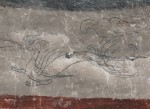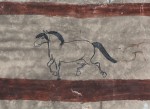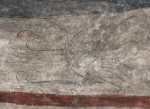 In the summer of 2008, experts from the Shanxi Provincial Institute of Archaeology and Shanxi Museum found a tomb in the ancient Fanwangsi Cemetery of Shuozhou City, a town in Shanxi province 200 miles southwest of Beijing, China. Built 1,500 years ago in the Northern Qi Dynasty, the tomb had been repeatedly looted and the only grave goods left were fragments from lower quality pottery figurines and glazed vessels. Besides those pieces, some wooden structural elements and a few iron nails that were probably once part of a canopy over the coffin were the only contents of the tomb remaining. Even the fan-shaped architrave over the doorway had been pried off.
In the summer of 2008, experts from the Shanxi Provincial Institute of Archaeology and Shanxi Museum found a tomb in the ancient Fanwangsi Cemetery of Shuozhou City, a town in Shanxi province 200 miles southwest of Beijing, China. Built 1,500 years ago in the Northern Qi Dynasty, the tomb had been repeatedly looted and the only grave goods left were fragments from lower quality pottery figurines and glazed vessels. Besides those pieces, some wooden structural elements and a few iron nails that were probably once part of a canopy over the coffin were the only contents of the tomb remaining. Even the fan-shaped architrave over the doorway had been pried off.
 Archaeologists were just in time, however, to save the true crowning glory of this tomb: richly colored murals painted on plastered walls and ceilings. Looters had already marked them for removal. There were blue lines drawn dividing the murals into discrete sections to guide the cutting tools and gauze fabric stuck to the murals in order to keep them from falling apart during the theft. Between June and August, the archaeological team excavated the tomb. In order to keep the paintings safe, to repair environmental and human damage and to ensure their rare ancient color remained brilliant, archaeologists decided to remove the murals. By the end of the summer, 860 square feet of murals were being restored at the Center for the Preservation of Cultural Relics of the Shanxi Museum.
Archaeologists were just in time, however, to save the true crowning glory of this tomb: richly colored murals painted on plastered walls and ceilings. Looters had already marked them for removal. There were blue lines drawn dividing the murals into discrete sections to guide the cutting tools and gauze fabric stuck to the murals in order to keep them from falling apart during the theft. Between June and August, the archaeological team excavated the tomb. In order to keep the paintings safe, to repair environmental and human damage and to ensure their rare ancient color remained brilliant, archaeologists decided to remove the murals. By the end of the summer, 860 square feet of murals were being restored at the Center for the Preservation of Cultural Relics of the Shanxi Museum.
 The murals begin on the walls of the passage tunnel leading into the main burial chamber. There are red ochre clouds on the vaulted ceiling and armed guards and cavalry troops on both sides of the tunnel. There’s a single door guard on the west wall leaning against his sword and a pair of honor guards inside the door frame. They too lean on their swords as they face each other. Approaching from a distance are three units of cavalry troops. The same types of figures are on the east wall, the only difference being the orientation of the cavalry.
The murals begin on the walls of the passage tunnel leading into the main burial chamber. There are red ochre clouds on the vaulted ceiling and armed guards and cavalry troops on both sides of the tunnel. There’s a single door guard on the west wall leaning against his sword and a pair of honor guards inside the door frame. They too lean on their swords as they face each other. Approaching from a distance are three units of cavalry troops. The same types of figures are on the east wall, the only difference being the orientation of the cavalry.
 Passing from the tunnel through the doorway into the tomb chamber, the murals cover the floor to the ceiling in three sections. The domed ceiling is painted with a sky map. A dark grey background symbolizes celestial infinity and the silver river winding through the grey is the Milky Way. White dots on both sides of the Milky Way are stars. On the east side of the heavens is a solar orb with a crow in the middle. Across from it on the west side of the ceiling is the moon with the Lunar Hare and toad inside.
Passing from the tunnel through the doorway into the tomb chamber, the murals cover the floor to the ceiling in three sections. The domed ceiling is painted with a sky map. A dark grey background symbolizes celestial infinity and the silver river winding through the grey is the Milky Way. White dots on both sides of the Milky Way are stars. On the east side of the heavens is a solar orb with a crow in the middle. Across from it on the west side of the ceiling is the moon with the Lunar Hare and toad inside.
 Beneath the sky map are the Four Supernatural Beings — the Green Dragon, White Tiger, Scarlet Bird and Black Tortoise — each guarding one of the cardinal directions. Beneath the Supernatural Beings the twelve animals of the Chinese zodiac frolic counter-clockwise in a band around the dome.
Beneath the sky map are the Four Supernatural Beings — the Green Dragon, White Tiger, Scarlet Bird and Black Tortoise — each guarding one of the cardinal directions. Beneath the Supernatural Beings the twelve animals of the Chinese zodiac frolic counter-clockwise in a band around the dome.
 Human figures come back into prominence on the walls of the burial chamber. On the north wall a man and a woman sit underneath a canopy at a banquet. These are probably images of the occupants of the tomb. On one side of the canopy female attendants stand, on the other male and female musicians entertain. The women attendants and the hostess wear their hair in the distinctive flying bird style.
Human figures come back into prominence on the walls of the burial chamber. On the north wall a man and a woman sit underneath a canopy at a banquet. These are probably images of the occupants of the tomb. On one side of the canopy female attendants stand, on the other male and female musicians entertain. The women attendants and the hostess wear their hair in the distinctive flying bird style.
 The banquet is guarded by more cavalrymen and honor guards on the east wall. Of particular note is a tall light red horse in the center of the image. A line of honor guards stand in front of the horse and attendants carry equipment while in the distance two lines of cavalry approach. It’s a proud display, a procession moving from south to north.
The banquet is guarded by more cavalrymen and honor guards on the east wall. Of particular note is a tall light red horse in the center of the image. A line of honor guards stand in front of the horse and attendants carry equipment while in the distance two lines of cavalry approach. It’s a proud display, a procession moving from south to north.
 On the west wall is a procession going in the other direction, north to south. In the center of this panel is an ox cart with an arched canopy and awnings. The ox is being driven by two non-Chinese men, so identified by their curly beards. Female attendants with flying bird chignons follow the cart, and yet another honor guard of five men on horses holding pennants are painted above the ox.
On the west wall is a procession going in the other direction, north to south. In the center of this panel is an ox cart with an arched canopy and awnings. The ox is being driven by two non-Chinese men, so identified by their curly beards. Female attendants with flying bird chignons follow the cart, and yet another honor guard of five men on horses holding pennants are painted above the ox.
 The last wall, the south wall, has the doorway in the middle. Around the entrance are two symmetrical sets of musicians. They stand side by side facing each other as they hold long horns so they cross each other at the top.
The last wall, the south wall, has the doorway in the middle. Around the entrance are two symmetrical sets of musicians. They stand side by side facing each other as they hold long horns so they cross each other at the top.
Such an elaborate set of murals suggest this was the tomb of a high-ranking official. Researchers believe he may have been the local militia leader under the Northern Qi Dynasty, a turbulent period of less than 30  years (550 to 577 A.D.) in which military leaders would have been very highly valued indeed. There are few records covering the history of Shuozhou City during the Northern Qi, and very few archaeological remains have been excavated. This was the first proper scientific excavation of a Northern Qi tomb in Shuozhou and is thus an invaluable source of information about an obscure period.
years (550 to 577 A.D.) in which military leaders would have been very highly valued indeed. There are few records covering the history of Shuozhou City during the Northern Qi, and very few archaeological remains have been excavated. This was the first proper scientific excavation of a Northern Qi tomb in Shuozhou and is thus an invaluable source of information about an obscure period.
It took four years of work to restore the murals. They are now divided into 31 sections on aviation aluminum panels so they can be dismantled and transported for exhibition.



